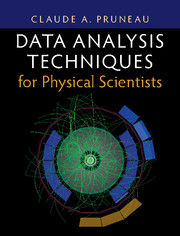14 - Collision and Detector Modeling
from Part III - Simulation Techniques
Published online by Cambridge University Press: 24 October 2017
Summary
In particle and nuclear physics, Monte Carlo simulations are used for a wide variety of purposes, including prediction and interpretation of results, studies of the performance of detectors and their components, as well as corrections of measured data to obtain accurate outcomes that are independent of experimental or instrumental effects. A detailed coverage of all the types of simulations used by particle and nuclear physicists is thus well beyond the scope of this text. We focus our discussion, in § 14.1, on basic techniques used in the simulation of simple physics observables, such as momentum spectra or correlation functions, while in § 14.2, we present simple techniques used in the simulation of detector performance and data correction for smearing and efficiency effects.
Event Generators
Simulations of particle production by elementary particles or nuclei collisions are based on phenomenological and theoretical models of varying complexity. A large variety of models predicated on a wide range of assumptions are described in the literature and used as practical event generators by theoreticians and experimentalists to describe and interpret measured results or analyze the performance of particle detectors. Commonly used event generators for the simulation of proton–proton collisions include JETSET [174], PYTHIA [175], HERWIG [66], PHOJET [52], EvtGen [133], and several others. There is an even greater variety of models for the generation and simulation of heavy-ion collisions. Early models used in the simulation of AGS, SPS, and RHIC collisions include HIJING [188], RQMD [176], URQMD [29], AMPT [137], VENUS [191], and EPOS [192]. More recent developments for the study of the interaction of jets within the medium produced in heavy-ion collisions include Martini [169], Jewel [198], Cujet [61], YaJEM [164], and many others. As noted earlier, we restrict the scope of our discussion to a small selection of phenomenological and theoretically motivated models, which illustrate how more complex generators are built and can be used to carry out simple simulations and analyses.
Basic Particle Generators
Basic simulations of particle production in elementary particle collisions often assume that produced particles are uncorrelated and have a kinematical distribution determined by a specific PDF.
- Type
- Chapter
- Information
- Data Analysis Techniques for Physical Scientists , pp. 663 - 686Publisher: Cambridge University PressPrint publication year: 2017



